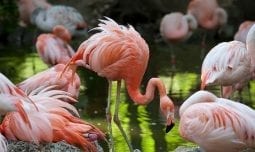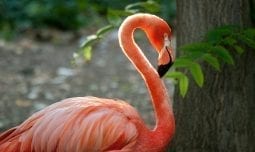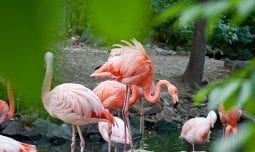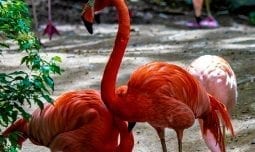Classification
Class Aves
Order Ciconiiformes
Family Phoenicopteridae
Genus Phoenicopterus
Species ruber
Habitat & Range
Saline lakes, coastal lagoons and other shallow salt water areas.
The American flamingo is found in coastal areas of the Caribbean including the Bahamas, Cuba, and the Yucatan peninsula. This species is also found throughout the southern United States, the Middle East, Africa, and northern South America.

American Flamingo
Phoenicopterus ruber
The flamingo’s brilliant pink or reddish feather color comes from its diet. The small crustaceans and algae that flamingoes eat contain a substance called beta-carotene that is deposited in the feathers. Without adequate amounts of beta-carotene in their diet, flamingo feathers gradually lose their brilliant color.
Adaptations
Legs
Flamingos use their long legs to wade into water much deeper than other wading birds. Their webbed feet allow them to swim well and provide support for walking in soft mud. When resting, flamingos tend to stand on one leg, drawing the other leg close to the body and tucking their head under a wing. While this position looks awkward and unstable, it helps to conserve body heat.
Filter Feeders
Flamingos have a unique feeding technique called filter feeding. As they walk along in the water, their feet stir up mud and water containing crustaceans, algae, and diatoms. Their long neck allows them to put their downward curving bill into the water and as they sweep their bill from side to side, water and food are collected in the bill.
In the Pink
The flamingo’s brilliant pink or reddish feather color comes from its diet. The small crustaceans and algae that flamingoes eat contain a substance called beta-carotene that is deposited in the feathers. (Carotene is a common substance in orange foods like carrots.) Without adequate amounts of beta-carotene in their diet, flamingo feathers gradually lose their brilliant color.
Physical Description
- American flamingos are up to five feet tall (1.5 m).
- American flamingos are up to five feet tall (1.5 m).
- They weigh five to six pounds (2.3-2.7 kg). Females are about 20% smaller than males.
- They have a wingspan of up to five feet (1.5 m).• Their feathers are a deep pinkish red with contrasting black on the outer edges of the wings.• Their distinctive bill is curves downward, and is beige at the base, pink in the middle and black at the tip.
- They have a large body, long pink legs with webbed feet, long necks and small heads.
Diet
What Does It Eat?
In the wild: Crustaceans, mollusks, insects, algae and diatoms containing carotenoid pigments.
At the zoo: Bird of prey diet, fish, soaked avian chow and flamingo pellets containing carotenoid pigments to maintain their bright pink feather color.
What Eats It?
A variety of predators such as birds of prey and gulls may prey on flamingos or their eggs.
Social Organization
Flamingos are highly gregarious birds living in large flocks that may number in the thousands. The birds participate in ritualized group displays that help synchronize breeding within the colony. They nest in colonies and the young are reared in group “nurseries” after they leave the nest. Thousands of birds migrate together to breeding sites.
Life Cycle
Within the colony, breeding is stimulated by elaborate group displays, which ensure synchronized egg laying, hatching and chick rearing. Courtship displays involve complex, synchronized dances that include neck stretching, wing spreading and neck twists along with ritualized preening and loud honking. Flamingos appear to be monogamous with pair bonding that sometimes continues to the next breeding cycle. Breeding pairs leave the group to build a nest consisting of mud formed into a cone about 12 inches high with a small depression in the center. The height of the nest keeps the eggs and chicks above any floodwaters and out of the reach of most predators. The female lays a single white egg in the nest, and both male and female incubate the egg, which hatches after 27-31 days. The chick is covered with gray downy feathers and has a straight bill. For five to 12 days the chick stays in the nest and is fed “crop milk” by both parents. When the chick leaves the nest it is able to walk and swim, at which point the young chicks join nurseries tended by a few adults while other adults go off to feed. Parents recognize their own chick by calls and will feed only their own offspring. The chick is fed crop milk until it is able to filter feed on its own at four to six weeks. American flamingo chicks fledge at nine to 13 weeks and are not sexually mature until three to six years of age. Lifespan of flamingos is up to 50 years.
Fun Facts
- The color in flamingo feathers fades gradually in sunlight making the feathers unsuitable for the plumage trade.• The color in flamingo feathers fades gradually in sunlight making the feathers unsuitable for the plumage trade.
- Ancient Egyptian hieroglyphics used the flamingo to depict the color red.
- In “Alice in Wonderland” the croquet mallets in the Queen’s Croquet Grounds are flamingos!
- Only two groups of birds – flamingos and pigeons – feed their chicks on “milk” produced in the crops of both parent birds.• A group of flamingos is called a “stand.”
Conservation Status
IUCN Status: Least Concern
The American flamingo is currently vulnerable to population decline due to habitat loss. Once common throughout much of the world, these birds breed in remote inhospitable areas that make it difficult to study them. Some of the breeding areas are being used for commercial salt collection and the flamingos are still hunted as a food source. In 1999 the AZA began a conservation and research project in the Yucatan to study the movement, nutritional requirements and reproductive behaviors of these beautiful birds. Despite threats the IUCN classifies this species as least concern due to its’ large range and a high estimated population size.

Download the App!
Get the FREE Denver Zoo app today, and be a pro the next time you visit the Zoo. You’ll get access to the Zoo map, daily activities and schedules, animal facts, and more. You can even load your membership card onto the app for additional convenience. It puts everything you need for an amazing Zoo experience right into the palm of your hand!






